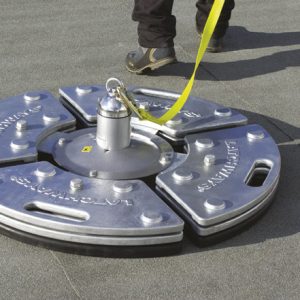Portable Single Point Anchors
Portable Single Point Anchors are common fall restraint solutions utilized for temporary construction, steel erection, and rooftop maintenance applications. For rooftop settings, Weighted Base Single Point Anchors provide free standing tie-off points, eliminating the need to attach to the roof surface. Portable Single Point Anchors for construction applications may attach to structural steel, window and door jams, or concrete, parapet walls. Cost effective and easy to install, Portable Single Point Anchors provide OSHA complaint fall protection solutions for clearly designated work areas where a high degree of mobility is not required to complete job duties.


We are a complete turnkey provider of OSHA compliant fall protection systems and have years of experience designing and installing portable single point anchors. Contact us for expert assistance with your fall arrest, fall restraint and fall protection requirements.
Applications
-
Construction
View Construction -
Roof Fall Protection
View Roof Fall Protection -
Steel Erection
View Steel Erection
Design Considerations
The use of weighted base single point anchors will subject your roof to a 700 lb load in a concentrated area. For this reason, it is imperative to ensure that the structural integrity of the roof sound. Weighted base single point anchors are not recommended for pitches in excess of 5 degrees. Portable single point anchors for construction applications are mechanically attached, requiring no drilling of concrete or structural steel. Non-engineered single point anchors must be rated rated at 5,000 for one user or 10,000lbs for two users. Engineered systems must be designed for 2 times the applied load in the event of a fall by a qualified person. A single point anchor may be designed for single or dual tie-off as long as each user attaches to a designated D-Ring. Multiple users should never tie off to the same D-Ring under any circumstances. Special care must be taken to train personnel in the proper use of single point anchors. An SPA is designed to protect workers within a 30 degree conical cone; moving outside the intended coverage area increases the likelihood of coming into contact with structure below the work area in the event of a swing fall.
OSHA Regulations
- Single Point Anchors
- 1926.502(d)(15) Anchorages used for attachment of personal fall arrest equipment shall be independent of any anchorage being used to support or suspend platforms and capable of supporting at least 5,000 pounds (22.2 kN) per employee attached, or shall be designed, installed, and used as follows:
- 1926.502(d)(15)(i) as part of a complete personal fall arrest system which maintains a safety factor of at least two; and
- 1926.502(d)(15)(ii) under the supervision of a qualified person.
- Connectors must be drop forged, pressed or formed steel, or made of equivalent materials. 1910.140(c)(2)
- Connectors must have a corrosion-resistant finish, and all surfaces and edges must be smooth to prevent damage to interfacing parts of the system. 1910.140(c)(3)
- When vertical lifelines are used, each employee must be attached to a separate lifeline. 1910.140(c)(4)
- Lanyards and vertical lifelines must have a minimum breaking strength of 5,000 pounds (22.2 kN). 1910.140(c)(5)
- Self-retracting lifelines and lanyards that automatically limit free fall distance to 2 feet (0.61 m) or less must have components capable of sustaining a minimum tensile load of 3,000 pounds (13.3 kN) applied to the device with the lifeline or lanyard in the fully extended position. 1910.140(c)(6)
- A competent person or qualified person must inspect each knot in a lanyard or vertical lifeline to ensure that it meets the requirements of paragraphs (c)(4) and (5) of this section before any employee uses the lanyard or lifeline. 1910.140(c)(7)
- D-rings, snaphooks, and carabiners must be capable of sustaining a minimum tensile load of 5,000 pounds (22.2 kN). 1910.140(c)(8)
- D-rings, snaphooks, and carabiners must be proof tested to a minimum tensile load of 3,600 pounds (16 kN) without cracking, breaking, or incurring permanent deformation. The gate strength of snaphooks and carabiners, must be proof tested to 3,600 lbs. (16 kN) in all directions. 1910.140(c)(9)
- Snaphooks and carabiners must be the automatic locking type that require at least two separate, consecutive movements to open. 1910.140(c)(10)
- Directly to webbing, rope, or wire rope; 1910.140(c)(10)(ii)
- To each other; 1910.140(c)(10)(iii)
- To a D-ring to which another snaphook, carabiner, or connector is attached; 1910.140(c)(10)(iv)
- To a horizontal life line; or 1910.140(c)(10)(v)
- To any object that is incompatibly shaped or dimensioned in relation to the snaphook or carabiner such that unintentional disengagement could occur when the connected object depresses the snaphook or carabiner gate, allowing the components to separate. 1910.140(c)(11)
Related Documents
Talk to a fall protection specialist
Tell us about your fall protection needs, and we’ll configure a system that rises to your challenges.

